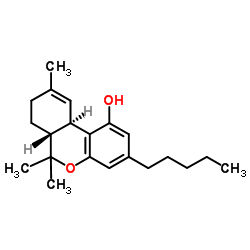(-)-δ9-trans-Tetrahydrocannabinol

(-)-δ9-trans-Tetrahydrocannabinol structure
|
Common Name | (-)-δ9-trans-Tetrahydrocannabinol | ||
|---|---|---|---|---|
| CAS Number | 1972-08-3 | Molecular Weight | 314.462 | |
| Density | 1.0±0.1 g/cm3 | Boiling Point | 390.4±42.0 °C at 760 mmHg | |
| Molecular Formula | C21H30O2 | Melting Point | N/A | |
| MSDS | USA | Flash Point | 149.3±22.1 °C | |
| Symbol |



GHS02, GHS06, GHS08 |
Signal Word | Danger | |
|
Cheminformatics analysis of assertions mined from literature that describe drug-induced liver injury in different species.
Chem. Res. Toxicol. 23 , 171-83, (2010) Drug-induced liver injury is one of the main causes of drug attrition. The ability to predict the liver effects of drug candidates from their chemical structures is critical to help guide experimental drug discovery projects toward safer medicines. In this st... |
|
|
Translating clinical findings into knowledge in drug safety evaluation--drug induced liver injury prediction system (DILIps).
J. Sci. Ind. Res. 65(10) , 808, (2006) Drug-induced liver injury (DILI) is a significant concern in drug development due to the poor concordance between preclinical and clinical findings of liver toxicity. We hypothesized that the DILI types (hepatotoxic side effects) seen in the clinic can be tra... |
|
|
Hologram QSAR model for the prediction of human oral bioavailability.
Bioorg. Med. Chem. 15 , 7738-45, (2007) A drug intended for use in humans should have an ideal balance of pharmacokinetics and safety, as well as potency and selectivity. Unfavorable pharmacokinetics can negatively affect the clinical development of many otherwise promising drug candidates. A varie... |
|
|
[Marihuana and cannobinoids as medicaments].
Prz. Lek. 69(10) , 1095-7, (2012) Biological activity of cannabinoids is caused by binding to two cannabinoid receptors CB1 and CB2. Psychoactive is not only tetrahydrocannabinol (THC) but also: cannabidiol, cannabigerol or cannabichromen. Formerly, the usefulness of hemp was assessed in the ... |
|
|
Trend analysis of a database of intravenous pharmacokinetic parameters in humans for 670 drug compounds.
Drug Metab. Dispos. 36 , 1385-405, (2008) We present herein a compilation and trend analysis of human i.v. pharmacokinetic data on 670 drugs representing, to our knowledge, the largest publicly available set of human clinical pharmacokinetic data. This data set provides the drug metabolism scientist ... |
|
|
Effects of a topically applied 2% delta-9-tetrahydrocannabinol ophthalmic solution on intraocular pressure and aqueous humor flow rate in clinically normal dogs.
Am. J. Vet. Res. 74(2) , 275-80, (2013) To determine the effects of topically applied 2% delta-9-tetrahydrocannabinol (THC) ophthalmic solution on aqueous humor flow rate (AHFR) and intraocular pressure (IOP) in clinically normal dogs.21 clinically normal dogs.A randomized longitudinal crossover de... |
|
|
Transient receptor potential ankyrin 1 (TRPA1) channel as emerging target for novel analgesics and anti-inflammatory agents.
J. Med. Chem. 53 , 5085-107, (2010)
|
|
|
Δ(9)Tetrahydrocannabinol impairs reversal learning but not extra-dimensional shifts in rhesus macaques.
Neuroscience 235 , 51-8, (2013) Expansion of medical marijuana use in the US and the recently successful decriminalization of recreational marijuana in two States elevates interest in the specific cognitive effects of Δ(9)tetrahydrocannabinol (Δ(9)THC), the major psychoactive constituent of... |
|
|
Antibacterial cannabinoids from Cannabis sativa: a structure-activity study.
J. Nat. Prod. 71 , 1427-30, (2008) Marijuana (Cannabis sativa) has long been known to contain antibacterial cannabinoids, whose potential to address antibiotic resistance has not yet been investigated. All five major cannabinoids (cannabidiol (1b), cannabichromene (2), cannabigerol (3b), Delta... |
|
|
Sensing with TRP channels.
Nat. Chem. Biol. 1 , 85-92, (2005) Drosophila melanogaster flies carrying the trp (transient receptor potential) mutation are rapidly blinded by bright light, because of the absence of a Ca2+-permeable ion channel in their photoreceptors. The identification of the trp gene and the search for h... |